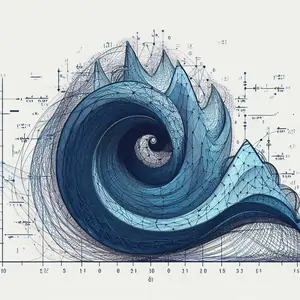Exploring the Connection Between Laplace Operator, Eigenvalues, and Eigenvectors in Solving Higher Dimensional Partial Differential Equations

Partial Differential Equations (PDEs) serve as powerful tools in understanding and modelling various physical phenomena, ranging from heat conduction to quantum mechanics. One essential concept in the realm of PDEs is the Laplace operator and its profound connection to eigenvalues and eigenvectors. In this comprehensive discussion, we delve into the theoretical underpinnings of the relationship between the Laplace operator and eigenvalues/eigenvectors, exploring how this connection facilitates the solution of PDEs in higher dimensions. This exploration is aimed at providing university students with valuable insights to enhance their understanding and proficiency in completing your matrix algebra assignment related to this complex subject matter.
The Laplace Operator:
Before we embark on the intricate relationship between the Laplace operator and eigenvalues/eigenvectors, let's establish a foundational understanding of the Laplace operator. In mathematical terms, the Laplace operator, denoted by Δ, is defined as the divergence of the gradient of a function. For a scalar function u(x), the Laplace operator is expressed as Δu = ∇²u.
In the context of PDEs, the Laplace operator often appears in equations describing the distribution of physical quantities, such as temperature, pressure, or concentration, over a given space. Understanding the behaviour of these quantities requires a deep exploration of the Laplace operator's properties and its connection to the eigenvalues and eigenvectors.

Eigenvalues and Eigenvectors:
Eigenvalues and eigenvectors play a pivotal role in linear algebra, offering a unique perspective on the behaviour of linear transformations. In the context of PDEs, they emerge as crucial components in the solution process. For a linear operator A, an eigenvalue λ and its corresponding eigenvector v satisfy the equation Av = λv.
The Relationship Unveiled:
Now, let's unravel the intricate relationship between the Laplace operator and eigenvalues/eigenvectors. Consider the eigenvalue problem for the Laplace operator in the form Δu = λu, where u is a function defined over a given domain. This seemingly simple equation conceals a wealth of mathematical intricacies that profoundly impact the solution of PDEs in higher dimensions.
Eigenfunctions of the Laplace operator, corresponding to distinct eigenvalues, form a complete set. This completeness property is a key aspect that facilitates the decomposition of complex functions into a series of simpler eigenfunctions. In the context of solving PDEs, this decomposition is instrumental in transforming the original problem into a series of simpler problems, each associated with a specific eigenvalue.
The Fourier Transform and Laplace Operator:
To further illustrate the connection, we delve into the Fourier transform, a mathematical tool that exploits the relationship between the Laplace operator and eigenvalues/eigenvectors. The Fourier transform provides a means to express a function in terms of its frequency components, revealing the eigenfunctions of the Laplace operator.
In higher dimensions, this spectral decomposition becomes particularly powerful. The eigenfunctions of the Laplace operator, often expressed as sinusoidal functions, unveil the spatial frequencies inherent in the system under consideration. This spectral perspective allows for a more nuanced analysis of complex PDEs, enabling the identification of dominant modes and their corresponding eigenvalues.
Applications in Higher Dimensional PDEs:
The applications of the Laplace operator's connection to eigenvalues and eigenvectors in solving higher dimensional Partial Differential Equations (PDEs) are profound and far-reaching. Let's delve deeper into how this understanding empowers students to write their maths assignments with confidence and unravel complex problems effectively.
1. Spectral Decomposition and System Analysis:
- In higher dimensional systems, the Laplace operator's eigenfunctions, often expressed as sinusoidal functions, provide a spectral decomposition of the problem. This means that complex functions can be expressed as a sum of simpler components, each associated with a specific eigenvalue.
- The spectral decomposition allows students to identify the fundamental modes or frequencies inherent in the system. These modes are represented by the eigenvalues, and their corresponding eigenvectors reveal the spatial patterns associated with each mode.
- By breaking down the system into these fundamental modes, students gain a more intuitive and nuanced understanding of the underlying dynamics. This approach is particularly valuable in fields such as physics, where the behaviour of physical quantities can be characterized by dominant modes.
2. Simplification of Higher Dimensional PDEs:
- Higher dimensional PDEs can be daunting due to their complexity. However, the relationship between the Laplace operator and eigenvalues/eigenvectors allows students to simplify these problems significantly.
- The eigenvalue problem associated with the Laplace operator, Δu = λu, leads to a set of eigenfunctions that form a complete basis for the function space. This completeness property enables the expansion of any well-behaved function in terms of these eigenfunctions.
- Through this expansion, the original PDE is transformed into a series of simpler PDEs, each associated with a specific eigenvalue. Solving these simpler problems becomes more manageable, and the summation of the solutions provides the solution to the original, higher dimensional PDE.
3. Efficient Solution Strategies:
- Armed with the spectral decomposition facilitated by eigenvalues and eigenvectors, students gain access to efficient solution strategies. The eigenfunctions provide a natural basis for expanding functions, making it easier to represent and manipulate complex solutions.
- Techniques such as the separation of variables and Fourier series expansions, rooted in the understanding of eigenvalues and eigenvectors, become powerful tools in the arsenal of students tackling higher dimensional PDEs. These techniques allow for systematic and step-by-step solutions, guiding students through the intricacies of the problem-solving process.
4. Insights into System Behavior:
- The fundamental modes identified through eigenvalues and eigenvectors offer insights into the behaviour of the system. Each eigenvalue corresponds to a specific mode of oscillation or variation, and the eigenvectors provide the spatial patterns associated with these modes.
- By analyzing the contributions of different eigenmodes, students can discern how the system responds to various perturbations or initial conditions. This understanding is invaluable in fields such as engineering, where predicting and controlling the behaviour of complex systems is essential.
The application of the Laplace operator's connection to eigenvalues and eigenvectors in higher dimensional PDEs provides a systematic and powerful approach to problem-solving. It not only simplifies the mathematical complexities but also enhances students' ability to gain deep insights into the fundamental characteristics of the systems they are studying. As students apply these principles to assignments, they develop a strong foundation for tackling real-world problems in diverse scientific and engineering domains.
Conclusion:
The deep relationship between the Laplace operator and eigenvalues/eigenvectors is a cornerstone in the theoretical framework of solving higher dimensional PDEs. By understanding this connection, university students gain a powerful toolset to dissect complex problems, paving the way for more efficient and insightful solutions. As they engage in assignments involving PDEs, this theoretical discussion serves as a guiding beacon, illuminating the path towards mastery in the fascinating realm of partial differential equations.